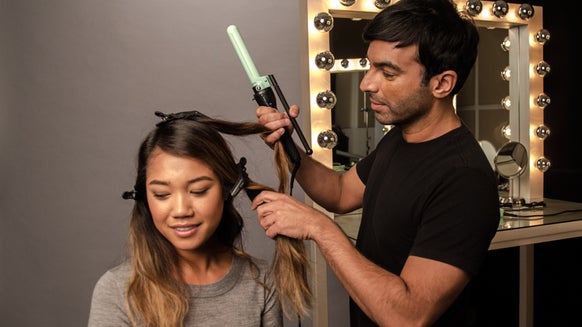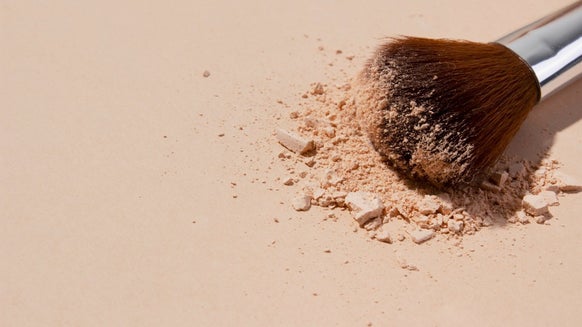What is Microneedling? A Comprehensive Guide to the Skin Rejuvenation Technique
Microneedling is one of the most innovative skincare treatments that's gained a popular reputation in the last decade. Loved for its transformative effects on the skin, microneedling involves using tiny needles to create controlled micro-injuries on the skin's surface. While the idea of deliberately puncturing the skin may sound daunting and even frightening, truth be told, the results are nothing short of remarkable.
No matter where you choose to do microneedling—yourself or in the hands of a professional—the treatment works by stimulating the skin's natural healing response and triggering the production of collagen and elastin, two essential proteins responsible for skin elasticity and firmness. As the skin repairs itself, it becomes thicker, smoother, and more even in tone, resulting in a rejuvenated complexion whether you're considering microneedling to improve acne scars, discoloration, wrinkles, and lines or to enhance the skin overall, consider this your ultimate microneedling guide.
Table of Contents:
- The Science Behind Microneedling
- How Microneedling Works on Your Skin
- The Benefits of Microneedling
- The Microneedling Procedure
- Microneedling Safety and Considerations
- Expert Advice for At-Home Microneedling and Dermarollers
- The Final Takeaway
The Science Behind Microneedling
Microneedling is a popular skin treatment used at home and by your dermatologist. Microneedling aims to improve collagen production, creating firmer, healthier skin with fewer wrinkles and lines, less pigment, and improved elasticity. Microneedling is also the go-to for improving unwanted skin pigmentation as well as softening out scars, particularly acne scars.
Whether you opt for microneedling at home or by a professional, the process is the same—the difference is the technology and machine and how deep the needles are inserted into the skin. Microneedling treatments rely on tiny sterile needles that safely puncture the skin to create micro-injuries. As the injuries heal, the skin is signaled to turn on its natural repair process and with that comes the creation of new collagen for firmer, healthier skin that's more even in tone.
For now, microneedling results are temporary at best yet still offer long-term improvement. Most dermatologists couple microneedling with radiofrequency (RF) heat-based energy (available only at a dermatologist's office) for optimal results and the most dramatic skin changes. The combination of RF with microneedling allows heat to be delivered deep into the skin while the microneedles simultaneously puncture the skin for longer improvements to the skin quality.
The most modern iteration of microneedling combines the procedure, at the hands of a professional, with PRP to address thinning hair and hair loss, promoting new hair growth by improving circulation and stimulating healthy activity in presently dormant hair follicles.
How Microneedling Works on Your Skin
The safe act of inserting tiny needles into the skin is a means of rejuvenation. By creating micro-wounds within the skin, the body recognizes it as an area that requires healing and in doing so, creates new collagen and elastin for more youthful-looking skin. Most at-home rollers, called dermarollers or microneedling rollers, contain needles that reach anywhere from 0.5 to 2.5 millimeters into the skin, which can create enough controlled injury at the surface level to incite new collagen production.
Creating new, better-organized collagen within the skin leaves the skin more even in tone and texture, with the common signs of aging less visible. With age, the skin naturally loses collagen, yet treatments that incite new collagen, like microneedling, lead to firmer skin to help the skin look healthier and younger.
The Benefits of Microneedling
One of the many reasons microneedling is a beloved skin rejuvenating treatment is that it can address many different skin-related concerns for immediate and long-term improvement. Some of the more noticeable changes in the skin that can be seen with regular microneedling sessions include:
- Improved skin texture and tone
- A reduction of fine lines and wrinkles
- Diminished scars and acne scars and hyperpigmentation
- Enhanced skin texture
- Improved collagen productions
- Reduction in sun damaged skin
- Smaller pores
- Better skin elasticity
- Hair regrowth
Microneedling alone has substantial skin benefits. However, pairing it with RF (available only through dermatologists) creates even more significant improvement in the skin texture and overall smoothness since the dual-prong approach heats the dermis to improve collagen further. This, in turn, creates a softening effect on wrinkles and acne scars while mildly tightening loose skin.
Unlike other treatments limited to just the skin on the face, microneedling is suitable for use across the entire face and can also address lip lines, hair loss on the scalp, and stretch marks elsewhere on the body.
Another major benefit of microneedling is that it has minimal downtime, a no-recovery period, and next to no downtime, making it a perfect treatment to do as you see fit.
The Microneedling Procedure
Microneedling can be done in the privacy of your own home or at your dermatologist’s office, but what you’ll experience is different if you take a DIY approach versus a professional one.
Professionally administered microneedling penetrates deeper into the skin than at-home rollers for more efficacious effects. The needles used at your dermatologist's office are housed within a mechanical pen-like device and are sharper than what a dermaroller contains. Although at-home dermarollers, which should always be sterilized before and after each use and only used on clean skin, are still effective and can provide noticeable results, they're gentler on the skin.
With advanced in-office microneedling treatments, dermatologists can choose the exact depth they want the needles to reach into the skin, whereas dermarollers can't be customized—each roller can only go as far into the skin as the needles are equipped to. On the other hand, professional microneedling treatments are a little more intense than using a roller at home. While they aren't excruciatingly painful, most doctors apply a layer of numbing cream before starting the procedure, which takes about 30 minutes. Certain areas, like the jawline, hairline, and forehead, are said to be more sensitive than others.
Post-microneedling, the skin may appear red or flush with pinpoint bleeding. The deeper the needles go, the more you'll notice this after a treatment. It will be more intense if your dermatologist microneedles your skin versus doing it yourself since most dermarollers don't create as deep of an injury to cause bleeding. For the most part, any skin redness will subside in a few hours so you can go about the rest of your day and your regular schedule.
No matter which version of microneedling you decide on, multiple treatments are needed to see the best results since the effects of microneedling are cumulative.
Microneedling Safety and Considerations
Like any other skin treatment, there is plenty to know about microneedling and the side effects that can arise if the treatment is not done right. For starters, overzealous microneedling, particularly when done at home, can cause broken capillaries. That's why it's important not to overdo it and stick to a routine of using a dermaroller bi-weekly rather than daily so that the skin has ample time to recover and heal between treatments. Professional treatments require even more time in between, typically four to six weeks.
Most people, even those with darker skin tones, can safely treat their skin with microneedling treatments, but what needs to be considered is how deep the needles should go and what your skin can handle. If you regularly deal with active acne, eczema, or psoriasis, microneedling may not suit you, so consult your dermatologist first.
It's essential to follow the proper post-aftercare instructions to minimize risks and maximize the treatment's benefits for both professional and at-home microneedling. Certain skincare ingredients, like exfoliating acids, including AHAs and BHAs, vitamin C, and retinol and retinoids, are considered no-go after the skin has been freshly microneedled since the skin is open and applying actives to it can cause a reaction or inflammation. Instead, it's best to layer on hyaluronic acid, peptides, or growth factors after microneedling so the skin can absorb these ingredients and put them to good use. It's also recommended to wash the skin with a gentler cleanser, wear sunscreen, avoid wearing makeup while the micro-wounds are still open, and avoid any activities that can cause sweat production. At-home microneedling is best reserved as a nighttime skincare routine so that the skin can heal while you sleep, and the open wounds are limited to any unnecessary exposure like sun and pollution.
Microneedling should never be done on inflamed or broken skin or over an active open acne lesion, which can create more damage and potentially spread acne bacteria across the skin.
Generally, the risks and side effects of any microneedling treatment are minimal. While it’s normal to experience some redness, pinkness, or slight tenderness across the skin, those symptoms are mild and subside on their own. Infections can occur if needles are pushed too deep into the skin, the roller or device is not sanitized before use, or if the skin does not heal fully in between each session.
Expert Advice for At-Home Microneedling and Dermarollers
1. Microneedling works on a variety of skin issues, including acne scars and crepey skin.
“Microneedling is a safe, chemical- and laser-free method that triggers new collagen production, regenerates skin cells and can also be used to help resurface the skin,” says Natalie Aguilar, a nurse and aesthetician who specializes in the treatment with her sister Nadia at their skin care boutique Afterglow Beverly Hills.
While most often used for resurfacing skin texture, it can help improve a variety of skin concerns, including discoloration, enlarged pores, acne scars, wrinkles, fine lines and crepey skin. If you don't have any major concerns, the therapy can also simply give skin a dewy and more youthful appearance, Aguilar says.
2. Microneedling can be customized according to your skin's needs.
An assessment of the client’s skin is typically conducted before the service is performed in order to prescribe the best course of treatment. “We set a clear goal to be reached and then select the best needle depth and most suitable serum for use with the therapy,” Aguilar shares. “Deep, pitted or severe acne scars would need a greater depth of needling as opposed to clients who are hoping to minimize pore size, which would require less depth.”
Serums used during treatment are customized according to the needs of the client. Aguilar uses caviar serum to restore moisture, minimize fine lines and improve skin turgor. Depigmentation serum, which is comprised of six skin lighteners, including glycolic acid, works to decrease the production of melanin and is used for discoloration. For clients with acne, Aguilar uses propolis serum, which minimizes inflammation, heals skin and controls sebum production with salicylic acid and propolis extract.
3. Microneedling shouldn’t hurt, but…
“In general, microneedling can definitely be painless, but it may feel a tiny bit awkward because of the ‘prickly’ sensation during treatment,” says Aguilar. However, when the depth of the needle is more extreme, additional precautions are advised. “For more severe skin issues, it would be best to numb with a topical anesthetic to make the client feel more at ease and comfortable throughout the procedure,” Aguilar advises.
While it is considered safe when done correctly, it’s important to ensure your esthetician is licensed to perform the service and is following hygienic practices. “Before commencing, we suggest making sure that the microneedling apparatus is sterile. Ask the technician to open the packaged needles in front of you for the utmost precaution in safety and infection control,” Aguilar suggests.
4. Unlike laser treatments, microneedling can be effective on all skin tones.
If you’re concerned about recovery time, burns or discoloration that can sometimes occur post-laser treatment, microneedling therapy is an excellent alternative. Like laser treatments, it can effectively lighten discoloration, resurface texture, stimulate collagen production and plump and tighten skin. It also has the added benefit of reliability. “Microneedling allows for a more predictable outcome for these skin issues,” Aguilar explains. Unlike lasers, microneedling is also a “color-blind” treatment, meaning it can be performed on clients of all skin tones.
5. Treatment cost varies according to your skin concern.
Treatments typically run $500.00 to $1,200.00 per service. A variety of factors can drive costs, including the specific serum used during the service and the amount of total treatments needed. These factors are determined by the needs of the client along with his or her age and skin type, which can influence the rate of response to treatment.
6. At-home microneedling devices take longer to take effect, but pose less risk.
While at-home
7. You can use your microneedling device on the body, too.
At-home microneedling devices also come in larger sizes, which allows you to treat larger areas---like abdomen, thighs, legs, buttocks, hands, arms, neck and back---twice as fast as you would with a smaller roller head. The ORA Microneedle Body Roller, for example, features a wide, double-sized head with 1,080 fine needles, and is "designed for use on any area of the body to diminish the appearance of scars, stretch marks, cellulite, wrinkles, fine lines and other blemishes," according to Perets. "The body roller also helps smooth uneven skin texture and color, and heavy pitted skin in all body areas."
8. There's a proper way to use a dermaroller.
As with any at-home beauty gadget, microneedling devices are not foolproof. Below is a step-by-step tutorial on how to use your dermaroller properly on your face or body. For best results, do this every three to five days. Also remember that since skin on the body is thicker than the skin on your face, it may take more than a few sessions before you can see visible results on your body.
The Final Takeaway
Microneedling is a favorite skin refreshing treatment that can dramatically improve the skin's tone and texture while reducing some of the more common signs of aging. This science-based way of inciting new collagen and elastin can significantly enhance skin health. Still, it's always best to consult a professional first for personalized advice.

Elise Minton Tabin is an award-winning beauty journalist, editor, and beauty expert with more than 16 years of experience. She previously held the title of Executive Beauty Editor at NewBeauty magazine, where she reported on beauty, plastic surgery, anti-aging, health and wellness. She was also instrumental in the launch of the beauty supplement brand Hush & Hush. A self-professed beauty junkie and retinol and sunscreen pusher, Elise knows what’s new, what works and who’s the best to go for every procedure under the sun. Follow Elise on Facebook, Instagram, and on her beauty blog, elisetabin.com
Related Posts

Everything You Need to Take Your Holiday Makeup Looks to the Next Level









